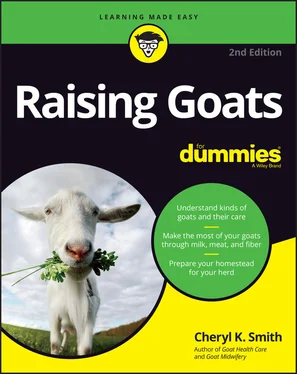Some people use goats to help children with autism improve their sensory abilities and social skills — there’s nothing like a cute pet to get people talking to you — and to improve morale and entertain residents of nursing homes. (I talk more about these benefits in Chapter 18.)
Raising goats as a 4-H project
Getting children involved in raising goats is a good way to teach responsibility. Keeping goats requires twice-a-day chores. Children quickly learn that the goats depend on them. They also find out about the cycle of birth and death and get outdoors to get regular exercise.
 Learning about and caring for goats as a 4-H project provides a structure that makes caring for goats fun and easy by giving the project a bigger purpose. Contact your county extension office for help on finding a 4-H group. If the 4-H group in your area is not set up so your kids can raise goats for a project, consider getting trained and starting your own goat 4-H group. Doing so not only gives your kids the opportunity for such a project, but it teaches responsibility, helps promote goats, and educates other children.
Learning about and caring for goats as a 4-H project provides a structure that makes caring for goats fun and easy by giving the project a bigger purpose. Contact your county extension office for help on finding a 4-H group. If the 4-H group in your area is not set up so your kids can raise goats for a project, consider getting trained and starting your own goat 4-H group. Doing so not only gives your kids the opportunity for such a project, but it teaches responsibility, helps promote goats, and educates other children.
Some of the things that children can do in a goat 4-H project include the following:
Developing a budget for goat care
Writing a report on and giving a speech about goats
Demonstrating hoof-trimming or other routine care ( Chapter 9)
Watching a goat show
Exhibiting the goat at the county or state fair ( Chapter 17)
Milking the goat and making cheese or yogurt ( Chapter 15)
Training the goat to walk on a lead ( Chapter 8)
Writing or drawing for a goat newsletter or magazine
Determining Whether Goats Are for You
You may love goats and the idea of raising them, but how do you know whether raising goats is right for you?
The first order of business is finding out everything you can about goats. You get a good start by reading this book. I also recommend that you spend time around goats. Ask goat people you’ve met whether you can go to their farms and observe or even help with their goats. Firsthand experience gives you an idea of what goats need and how you like working with them.
 Goats can live 15 years, or even longer. Unless you buy goats to be eaten, and especially if you plan to keep them as pets, remember that you’re taking on a long-term commitment just like you do when you get a dog or a cat.
Goats can live 15 years, or even longer. Unless you buy goats to be eaten, and especially if you plan to keep them as pets, remember that you’re taking on a long-term commitment just like you do when you get a dog or a cat.
The upcoming sections tell you more about considerations you need to mull over before you become a goat owner.
Expect to spend at least a half hour each morning and a half hour each evening on routine goat care. If you get a lot of goats or use them for a specialty such as milk, meat, or fiber, you need to budget more time. ( Part 4tells you about each of these situations.)
Goats need a supply of hay and/or browse (grasses and other plants they can find in a pasture) and clean water at all times. ( Chapter 6gives you the details on what goats eat.) The routine twice-daily care you need to plan for includes feeding, changing water, cleaning buckets, observing your goats to make sure they are healthy and acting normal, making sure they’re safe and secure each night, and letting them out in the morning. Of course, you probably want to spend more time just being with them after you discover how fascinating they are.
Plan also to spend an hour or more each month on regular grooming and goat care such as hoof trimming, injections or other treatment, and cleaning their living area. ( Chapter 9runs through the routine care that goats need.) If you breed, show, shear, or slaughter your goats, you spend many more hours with your goats intermittently. And if one of your goats gets sick, you need time to provide care or coordinate with a vet. ( Chapter 11addresses common illnesses.)
 If you work and don’t have a reliable helper, you need to have some flexibility to deal with problems. If you work outside your home and have long or erratic hours, a helper is essential.
If you work and don’t have a reliable helper, you need to have some flexibility to deal with problems. If you work outside your home and have long or erratic hours, a helper is essential.
Deciding which goats are right for your situation
You want to get the type of goat that’s right for your goals. If you want goats for milk, get dairy goats; for meat, get meat goats; for fiber, get fiber goats. If you have mixed goals, find out which animal will best suit all of them. For example, a Spanish goat can produce cashmere, kids for meat, and milk. The milk won’t be of the volume or quality you get with a dairy goat, but nevertheless, it’s milk. If you just want pets, miniature goats may be your best bet. And for brush control, bigger may be better. You can read more about the different breeds in Chapter 3.
 If you want pet goats, choose goats that are
If you want pet goats, choose goats that are
Tame and friendly: These goats are much easier to work with, and you won’t have to spend time trying to get them to trust you.
Horn-free: Goats without horns are the safest, especially around children. (I tell you more about the horns, including how to remove them before they grow, in Chapter 9.)
Wethers: Don’t ever accept or buy a buck goat for a pet. You will regret it as soon as he matures and starts to stink during breeding season. ( Chapter 12tells you about the weird and exciting world of breeding.) Does can make okay pets, but wethers are the best. They don’t go into heat, and they cost less to feed because they don’t need anything but minerals and good grass hay. They also are the sweetest.
If you live in a city, get miniature goats, not full-sized ones. They won’t take up as much room and then you can have more, if you want. By the same token, if you have a physical disability, miniature goats are better because they are easier to handle. You can read more about miniature goat breeds in Chapter 3.
If you’d like to raise and breed show goats, you probably want to get registered goats. There are many registries for goats, usually related to their use — for example, dairy goats, meat goats, or cashmere goats. I tell you more about showing goats in Chapter 17.
Finding out about local ordinances
Check out ordinances in your area regarding keeping livestock. These govern whether you can keep livestock and restrict the types you can keep. You need to be aware of the ordinances governing your area, or you risk losing the goats that you dreamed of getting just because of a technicality.
 A good place to start is with a city planning or zoning department. Make sure to get a copy of the rules or regulations that govern this. Jenny Grant, of the Seattle Justice League, who spearheaded the Seattle effort to allow miniature goats in that city, also recommends that you check with local animal control to determine whether they have the ability to deal with goats.
A good place to start is with a city planning or zoning department. Make sure to get a copy of the rules or regulations that govern this. Jenny Grant, of the Seattle Justice League, who spearheaded the Seattle effort to allow miniature goats in that city, also recommends that you check with local animal control to determine whether they have the ability to deal with goats.
In some cities, you may need to buy a license for a goat, just as you do for a dog. Another kind of ordinance that you need to be aware of governs noise. In rural areas, animals are expected (as are guns), so neighbors can’t do much legally about a crying goat (or target shooting). But in an urban area, even if goats are allowed, your neighbors may complain, much as they do with a barking dog. Be aware of what your local noise ordinance covers.
Читать дальше

 Learning about and caring for goats as a 4-H project provides a structure that makes caring for goats fun and easy by giving the project a bigger purpose. Contact your county extension office for help on finding a 4-H group. If the 4-H group in your area is not set up so your kids can raise goats for a project, consider getting trained and starting your own goat 4-H group. Doing so not only gives your kids the opportunity for such a project, but it teaches responsibility, helps promote goats, and educates other children.
Learning about and caring for goats as a 4-H project provides a structure that makes caring for goats fun and easy by giving the project a bigger purpose. Contact your county extension office for help on finding a 4-H group. If the 4-H group in your area is not set up so your kids can raise goats for a project, consider getting trained and starting your own goat 4-H group. Doing so not only gives your kids the opportunity for such a project, but it teaches responsibility, helps promote goats, and educates other children. Goats can live 15 years, or even longer. Unless you buy goats to be eaten, and especially if you plan to keep them as pets, remember that you’re taking on a long-term commitment just like you do when you get a dog or a cat.
Goats can live 15 years, or even longer. Unless you buy goats to be eaten, and especially if you plan to keep them as pets, remember that you’re taking on a long-term commitment just like you do when you get a dog or a cat.










